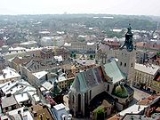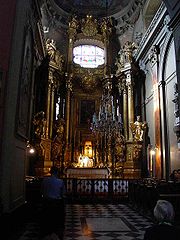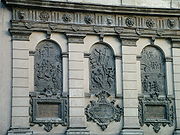
Latin Cathedral, Lviv
Encyclopedia
The Archcathedral Basilica of the Assumption of the Blessed Virgin Mary, in Lviv
, in western Ukraine
, usually called simply the Latin Cathedral , is located in city's Old Town
, in the south western corner of market square.

 The first church built on this site was a small wooden Roman Catholic church dedicated to the Holy Trinity, built in 1344 and lost in a fire six years later. In 1360 the king Casimir III of Poland
The first church built on this site was a small wooden Roman Catholic church dedicated to the Holy Trinity, built in 1344 and lost in a fire six years later. In 1360 the king Casimir III of Poland
founded the construction of the present day church, built in Gothic
style, for a cathedral of the newly created Latin diocese
. The church was consecrated in 1405 and the parish was moved here from the church of Mary of Snow. In 1412 the seat of the bishop was transferred from Halych
. Construction work continued throughout the 15th century and in 1481 the Cathedral was finally consecrated.
The cathedral witnessed many significant events and was visited by several Polish kings, most notably John II Casimir
, who in the Cathedral entrusted the Polish-Lithuanian Commonwealth
under the care of the Blessed Virgin in what came to known as the Lwów Oath
. In 1440 the Metropolitan of Kiev, Cardinal Isidore celebrate the Holy Mass offered for the intention of Christian Unity, when he stopped in Lviv returning from the Council of Florence
.
In the years 1761–1776 the Cathedral was refurbished in the Baroque
style and a tall bell tower was added. In 1776 the wonder working icon of the Mother of God held in the Cathedral was crowned and placed in the main altar. In 1892–1898 the presbytery was remodeled in the Neogothic style and stained glass
, designed by Józef Mehoffer
and Jan Matejko
were installed. In 1910 the Cathedral was granted the status of a minor basilica
by Pope St. Pius X
.
The Latin Cathedral is one of the just two churches in Lviv that weren't closed or subjected to the Muscovite Patriarchate during Soviet
rule (the other being the Roman Catholic church of St. Anthony in Lychakiv), however during that time the bishops resided in Lubaczów
, a town in southeastern Poland
, close to the border with Ukraine. In 1991 Pope John Paul II reactivated the diocese.
The wonder-working icon was moved to Kraków
after World War II
, and then in 1974 to the procathedral in Lubaczów; in 1983 it was once again crowned in Jasna Góra and presently remains in Lubaczów. The Lviv Cathedral presently owns a copy which was crowned by Pope John Paul II during his Apostolic Visit to Ukraine on June 26, 2001.
Lviv
Lviv is a city in western Ukraine. The city is regarded as one of the main cultural centres of today's Ukraine and historically has also been a major Polish and Jewish cultural center, as Poles and Jews were the two main ethnicities of the city until the outbreak of World War II and the following...
, in western Ukraine
Ukraine
Ukraine is a country in Eastern Europe. It has an area of 603,628 km², making it the second largest contiguous country on the European continent, after Russia...
, usually called simply the Latin Cathedral , is located in city's Old Town
Old Town (Lviv)
Lviv's Old Town is the historic centre of the western Ukrainian city of Lviv, in the Lviv Oblast , recognized as the State Historic-Architectural Sanctuary in 1975.-UNESCO:...
, in the south western corner of market square.


Casimir III of Poland
Casimir III the Great , last King of Poland from the Piast dynasty , was the son of King Władysław I the Elbow-high and Hedwig of Kalisz.-Biography:...
founded the construction of the present day church, built in Gothic
Gothic architecture
Gothic architecture is a style of architecture that flourished during the high and late medieval period. It evolved from Romanesque architecture and was succeeded by Renaissance architecture....
style, for a cathedral of the newly created Latin diocese
Roman Catholic Archdiocese of Lviv
The Archdiocese of Lviv of the Latins is a metropolitan archdiocese of the Latin Rite of the Catholic Church in western Ukraine. Archbishop Mieczyslaw Mokrzycki is the current metropolitan archbishop of the archdiocese.- History :...
. The church was consecrated in 1405 and the parish was moved here from the church of Mary of Snow. In 1412 the seat of the bishop was transferred from Halych
Halych
Halych is a historic city on the Dniester River in western Ukraine. The town gave its name to the historic province and kingdom of Kingdom of Galicia–Volhynia, of which it was the capital until the early 14th century, when the seat of the local princes was moved to Lviv...
. Construction work continued throughout the 15th century and in 1481 the Cathedral was finally consecrated.
The cathedral witnessed many significant events and was visited by several Polish kings, most notably John II Casimir
John II Casimir of Poland
John II Casimir was King of Poland and Grand Duke of Lithuania during the era of the Polish–Lithuanian Commonwealth, Duke of Opole in Upper Silesia, and titular King of Sweden 1648–1660. In Poland, he is known and commonly referred as Jan Kazimierz. His parents were Sigismund III Vasa and...
, who in the Cathedral entrusted the Polish-Lithuanian Commonwealth
Polish-Lithuanian Commonwealth
The Polish–Lithuanian Commonwealth was a dualistic state of Poland and Lithuania ruled by a common monarch. It was the largest and one of the most populous countries of 16th- and 17th‑century Europe with some and a multi-ethnic population of 11 million at its peak in the early 17th century...
under the care of the Blessed Virgin in what came to known as the Lwów Oath
Lwów Oath
Lwów Oath – An oath made on April 1, 1656 by Polish king John II Casimir in Latin cathedral in the city of Lwów .-Background:...
. In 1440 the Metropolitan of Kiev, Cardinal Isidore celebrate the Holy Mass offered for the intention of Christian Unity, when he stopped in Lviv returning from the Council of Florence
Council of Florence
The Council of Florence was an Ecumenical Council of the Roman Catholic Church. It began in 1431 in Basel, Switzerland, and became known as the Council of Ferrara after its transfer to Ferrara was decreed by Pope Eugene IV, to convene in 1438...
.
In the years 1761–1776 the Cathedral was refurbished in the Baroque
Baroque
The Baroque is a period and the style that used exaggerated motion and clear, easily interpreted detail to produce drama, tension, exuberance, and grandeur in sculpture, painting, literature, dance, and music...
style and a tall bell tower was added. In 1776 the wonder working icon of the Mother of God held in the Cathedral was crowned and placed in the main altar. In 1892–1898 the presbytery was remodeled in the Neogothic style and stained glass
Stained glass
The term stained glass can refer to coloured glass as a material or to works produced from it. Throughout its thousand-year history, the term has been applied almost exclusively to the windows of churches and other significant buildings...
, designed by Józef Mehoffer
Józef Mehoffer
Józef Mehoffer was a Polish painter and decorative artist, one of the leading artists of the Young Poland movement and one of the most revered Polish artists of his time.-Life:...
and Jan Matejko
Jan Matejko
Jan Matejko was a Polish painter known for paintings of notable historical Polish political and military events. His most famous works include oil on canvas paintings like Battle of Grunwald, paintings of numerous other battles and court scenes, and a gallery of Polish kings...
were installed. In 1910 the Cathedral was granted the status of a minor basilica
Minor basilica
Minor basilica is a title given to some Roman Catholic churches. By canon law no Catholic church can be honoured with the title of basilica unless by apostolic grant or from immemorial custom....
by Pope St. Pius X
Pope Pius X
Pope Saint Pius X , born Giuseppe Melchiorre Sarto, was the 257th Pope of the Catholic Church, serving from 1903 to 1914. He was the first pope since Pope Pius V to be canonized. Pius X rejected modernist interpretations of Catholic doctrine, promoting traditional devotional practices and orthodox...
.
The Latin Cathedral is one of the just two churches in Lviv that weren't closed or subjected to the Muscovite Patriarchate during Soviet
Soviet Union
The Soviet Union , officially the Union of Soviet Socialist Republics , was a constitutionally socialist state that existed in Eurasia between 1922 and 1991....
rule (the other being the Roman Catholic church of St. Anthony in Lychakiv), however during that time the bishops resided in Lubaczów
Lubaczów
Lubaczów is a town in southeastern Poland, close to the border with Ukraine, with 12,405 inhabitants .Situated in the Subcarpathian Voivodeship , it is the capital of Lubaczów County and is located 50 kilometers northeast of Przemyśl....
, a town in southeastern Poland
Poland
Poland , officially the Republic of Poland , is a country in Central Europe bordered by Germany to the west; the Czech Republic and Slovakia to the south; Ukraine, Belarus and Lithuania to the east; and the Baltic Sea and Kaliningrad Oblast, a Russian exclave, to the north...
, close to the border with Ukraine. In 1991 Pope John Paul II reactivated the diocese.
The wonder-working icon was moved to Kraków
Kraków
Kraków also Krakow, or Cracow , is the second largest and one of the oldest cities in Poland. Situated on the Vistula River in the Lesser Poland region, the city dates back to the 7th century. Kraków has traditionally been one of the leading centres of Polish academic, cultural, and artistic life...
after World War II
World War II
World War II, or the Second World War , was a global conflict lasting from 1939 to 1945, involving most of the world's nations—including all of the great powers—eventually forming two opposing military alliances: the Allies and the Axis...
, and then in 1974 to the procathedral in Lubaczów; in 1983 it was once again crowned in Jasna Góra and presently remains in Lubaczów. The Lviv Cathedral presently owns a copy which was crowned by Pope John Paul II during his Apostolic Visit to Ukraine on June 26, 2001.

